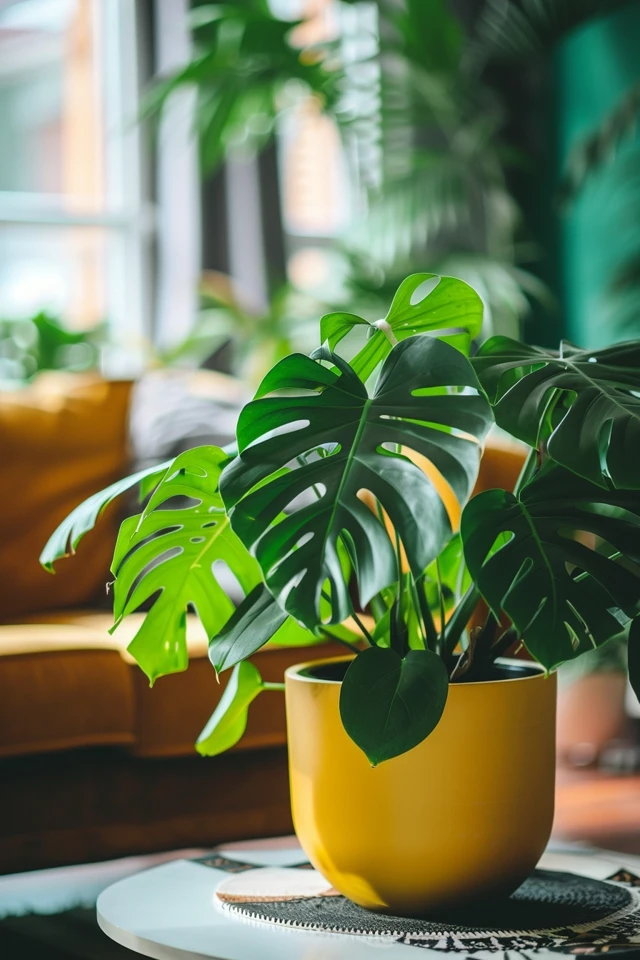Repotting a monstera plant is an essential task to ensure its healthy growth. Monstera plants are known for their climbing nature and often require repotting every two years, especially when supported by a moss pole.
By repotting your monstera with a pole, you’re providing the plant with the necessary support it needs to thrive. This process enables the monstera’s roots to have more space to grow, prevents soil compaction, and allows for fresh soil and nutrients to be replenished.
The ideal time to repot your monstera is in early spring when it’s experiencing a growth spurt. When selecting a new pot, choose one that is slightly larger in diameter than the old pot but deeper to accommodate the moss pole securely.
It’s essential to use well-draining soil, such as premium potting mix, to ensure proper water drainage and air circulation within the roots. Carefully remove the monstera from its old pot, being mindful of the delicate roots, and place it in the new pot, arranging it around the pole if necessary.
Fill in the gaps with potting soil, water the plant thoroughly, and allow it to adjust to its new environment before fertilizing. Repotting a monstera with a pole may require the assistance of a friend for larger plants and can be a slightly more challenging process than repotting other plants, but with proper guidance, it can be successfully done.

Key Takeaways:
- Repotting a monstera plant with a pole provides essential support for its climbing nature.
- Choose a slightly larger pot with adequate depth to accommodate the moss pole securely.
- Use well-draining soil to prevent waterlogging and provide proper air circulation to the roots.
- Be careful when removing the monstera from its old pot, taking care not to damage its delicate roots.
- Allow the monstera to adjust to its new pot before fertilizing.
Why Use a Pole for Repotting a Monstera
Using a pole for repotting a monstera plant, specifically a moss or coir pole, offers several benefits. In its natural habitat, a monstera plant uses its aerial roots to cling to and draw moisture from the bark of tall rainforest trees. A moss or coir pole mimics this natural environment, providing the roots with something to grab onto and draw moisture from.
The use of a pole allows the monstera to grow upward, providing supportive growth and preventing the plant from sprawling out. Moss totems and coir poles are the recommended options for monstera plants, as they offer stability and the ability for aerial roots to latch on to the surface. These poles can be easily installed in the pot and provide a natural surface for the monstera to grow on.
The choice of using a pole for support depends on the individual plant and its growth habits, but it can help create a fuller, more column-like shape for the monstera.

Tips for Training a Monstera Around a Support
When it comes to training your monstera plant to grow around a support, selecting the right type of support is key. You have several options to choose from, including multiple bamboo canes, U-shaped cane supports, homemade sphagnum moss poles, and coco coir poles. For optimal results, I recommend using sphagnum moss poles due to their moisture-retaining properties that create a favorable environment for the growth of aerial roots.
When placing the support in the pot, make sure it is deep enough to provide stability for your monstera plant. In case repotting becomes necessary, handle the process with care. Gently remove the monstera from its old pot and examine the roots for any signs of drying or shriveling. Repot the plant into a new container, arranging the stems around the support, and filling the gaps with the best soil for monstera repotting – a quality potting mix. To keep the monstera securely attached to the support, you can use various types of plant ties.
Regular misting of the moss or coir pole can help maintain the monstera’s interest in the support and promote root growth. Remember to care for your monstera with a support just like you would care for a plant without support. This includes providing proper watering, ensuring good drainage, and placing the plant in a brightly lit area with indirect light. Additionally, regular adjustments of the support may be required to accommodate new growth and maintain overall stability. Training a monstera plant around a support may require patience and experimentation, but the end result is worth it – a beautifully displayed and well-supported plant.


